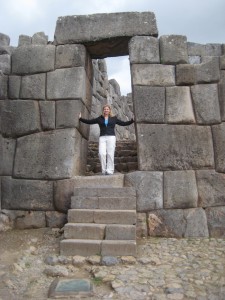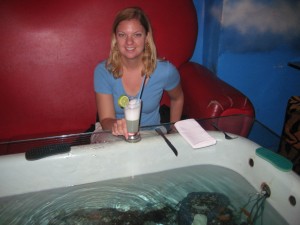Long second day in Peru! I suppose we should be taking it easy as we get used to the altitude and rest up for the Inca Trail, but today didn’t turn out that way.
We were both up and going by around 8 this morning after getting to bed around 10 last night. The hotel breakfast was good – eggs and sausage, mini hot cakes, bread, ham, fruit, yogurt and cereal. Definitely a good spread. After breakfast, we had a few errands to run. First, we went back to the Peru Treks office to book our trip to the Sacred Valley tomorrow. Then, we stopped to get cash, I bought an extra camera battery – just in case I need one on the Inca Trail – and we bought our “boleto turistico” – a tourist ticket that gets us into 16 sights in and around Cusco and the Sacred Valley. I was able to speak Spanish a bit while we were running errands, including a whole conversation with the woman selling me the camera battery about whether or not I could return it after the Inca Trail if I didn’t end up using it. Unfortunately, no.

Then, we stopped back at the hotel to have the desk call a taxi for us to go see four sets of ruins near Cusco – Tambomachay, Puka Pukara, Qenko and Sacsayhuaman. We got picked up around 10:30 a.m. by a taxi with a driver named Jose who spoke not much English so I got to try some more Spanish. Yay! I was feeling pretty comfortable with it already! We also got treated to some good 90s hair band tunes – Sweet Child of Mine and some Aerosmith.
Our first stop was the furthest out – Tambomachay. My guidebook said to plan on spending an hour there but when I asked Jose how much time, we said 30 minutes. That ended up being about right. We walked up a stone path for a few minutes, passing some llamas or alpacas (I haven’t figured out which is which yet – would like to think they’re all llamas since I ate alpaca last night!). Then we got to some small ruins with some small water fountains. It was fairly unimpressive and while we tried to listen into a tour group, we didn’t have much of an idea at all of what we were seeing. On the way out, I paid 2 soles to take a picture of a woman with a baby llama/alpaca. Not crazy about how it turned out though – the woman looked like she was strangling the poor thing! I’m really not sure what the author of my guidebook was doing at Tambomachay for an hour, 20 minutes ended up being just fine for us!

Next stop was Puka Pukara. This is a small fortress which is thought to have been a guard post on the road from Cusco to the villages of the Sacred Valley. There, we met a guide, Javier, who initially offered to show us around Puka Pukara for no fee, just a tip at the end. He said it was his day off, and he just wanted to practice his English. He spoke pretty decent English and seemed to explain stuff pretty well – we definitely wouldn’t have had a clue without some explanation and we were kind of wishing we had run into him at Tambomachay! For example, he told us how there was a window that served as a checkpoint where they tied knots in a rope to keep track of the people passing through on the way to Cusco. He also pointed out the difference in the way the stones with no clay/cement in between them represents a sacred building, while the stones with mud are buildings for the lower class.
Toward the end of our “tour” of Puka Pukara, Javier offered to guide us to Qenko and Sacsayhuaman too. We were initially a little reluctant but he seemed good and the price was decent – 60 soles total ($10 each). So we went for it and Javier joined us with Jose in the taxi and we headed to Qenko.

Qenko was interesting – a sort of amphitheatre as well as a large altar that is supposedly situated so that on June 24, the sun hits it and reflects a shadow shaped like a puma, which is a very important animal to the Incas. There were also some caves that we went through – partly completely black and very tight! It was a little scary. Then we also saw a cave with a smooth stone table that Javier explained was used to kill llamas. There was a drain for the blood to run down and it meant different things depending on the direction it flowed. We also saw a lot of places where mummies used to be left to dry.
Last stop was Sacsayhuaman, the largest of the ruins so far. There, we decided not to have Jose wait for us so we could walk the 20 minutes or so (downhill) back to Cusco. Even though we had thought we had agreed on 50 soles for the trip, Jose insisted we pay him 60, saying he had to pay the hotel 10. We didn’t buy that at all, but we paid the extra money (and in retrospect, we should’ve actually paid less since we weren’t having him wait at the end for us!). But all in all, it was $20 total for several hours of the taxi driving and waiting so that wasn’t too bad, considering it costs me more than that just to take a taxi from downtown Chicago to my home on the north side.
Anyway, we spent quite a while at Sacsayhuaman (often pronounced “Sexy Woman” by tourists and locals alike). We started by seeing some caves and catacombs. I don’t completely remember what Javier said took place in there – something spiritual and having to do with death I’m guessing. Next we went through a tunnel to come out to a large field which seems to have been more of an amphitheatre at one point. Javier said the people would gather there to hear the Inca speak – sort of a meeting or reunion when the Inca returned from war. From there Javier stopped and explained to us the meaning of the Inca cross – it has 4 points which stand for the 4 Inca regions and each side appears to have 3 steps, which represent the 3 gods, condor, puma and snake.

Next, we stopped at some very cool rock slides where we took turns sliding down. Pretty fun and a bit of a rush, although luckily not too long. After the slides, we headed down to another very wide open field where ceremonies and festivals were held in Inca times and where festivals are still held today. It was kind of amazing to hear how many thousands of people come today to the festivals and walk all over this major historical sight. We could also see on the sides where parts of the walls had very clearly been reconstructed and the reconstruction did not match at all with the original. Kind of sad.

After that, Javier took us to an alpaca factory, likely hoping we would buy something to get him a commission. It was nice to see the difference between the different types of alpaca and the prices – just to know for comparison when we shop later. Then we parted ways with Javier after getting his contact info in case we want to use him for another trip while in Cusco. Kelsey and I then headed back to Sacsayhuaman to explore and take some more pictures before walking back into Cusco. By the time we got to Cusco, it was nearly 4 p.m. and we were starving! We stumbled upon the bar/restaurant Fallen Angel, which our taxi friends from yesterday recommended. It was definitely interesting! We ate lunch off a table made out of a bathtub aquarium! The food was delicious though – and reasonably priced by U.S. standards – we paid $24 each for steak and a drink (Pisco Sour!) and a bottle of water. And the steak was really good.
Fallen Angel happened to be next door to the Museum of Precolumbian Art, which also came highly recommended so we visited that after our late lunch. It’s in an old house with a courtyard and was fairly empty. It was interesting and had nice English explanations of everything, but nothing really stood out. Not overly exciting.

By then it was getting really chilly and dark so when we left we headed back down through the main plaza toward the hotel, stopping a few times at some shops along the way. We went to bed fairly early again, by around 10:30, since we were getting picked up early for our full day tour of the Sacred Valley the next day.
